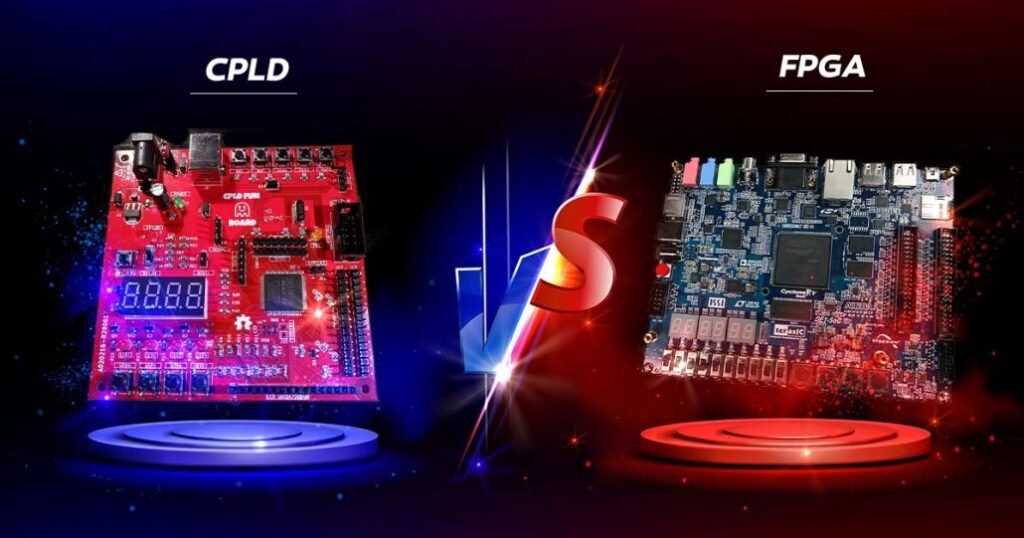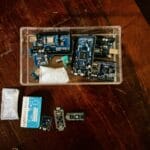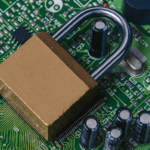FPGA and CPLD are two types of digital logic devices that are widely used in electronic circuits. FPGA stands for Field Programmable Gate Array, while CPLD stands for Complex Programmable Logic Device. Both of these devices are used to implement digital logic circuits, but they differ in their architecture and capabilities.
FPGAs are highly flexible devices that can be programmed to perform any digital logic function. They consist of a large number of configurable logic blocks that can be connected to form complex circuits. FPGAs are commonly used in applications such as digital signal processing, image processing, and high-speed data communication.
CPLDs, on the other hand, are smaller and less flexible than FPGAs, but they are still very useful for implementing medium-sized logic circuits. CPLDs consist of several logic blocks that are interconnected by programmable switches. They are commonly used in applications such as control systems, automotive electronics, and industrial automation. In the following sections, we will discuss the architecture and capabilities of both FPGA and CPLD in more detail.
Fundamentals of Digital Logic
Logic Gates and Boolean Algebra
Digital logic is the foundation of modern electronic devices. It is the study of electronic circuits that operate on digital signals, which are either high or low (1 or 0). The building blocks of digital logic circuits are logic gates, which are electronic circuits that perform a Boolean logic function. There are several types of logic gates, including AND, OR, NOT, NAND, NOR, and XOR gates.
Boolean algebra is a mathematical system that deals with logical variables and logical operations. It is used to analyze and simplify digital logic circuits. In Boolean algebra, logical variables are represented by symbols, such as A, B, C, etc. Logical operations are represented by symbols, such as + (OR), · (AND), and ̅ (NOT). Boolean algebra has several laws, such as the distributive law, the associative law, and the commutative law, which are used to simplify digital logic circuits.
Combinatorial vs. Sequential Logic
Combinatorial logic circuits are digital logic circuits that have no memory. They perform a Boolean logic function on their inputs and produce an output based on that function. Combinatorial logic circuits are used in many applications, such as calculators, digital clocks, and traffic lights.
Sequential logic circuits are digital logic circuits that have memory. They store information and produce an output based on that information. Sequential logic circuits are used in many applications, such as flip-flops, counters, and registers. Sequential logic circuits can be synchronous or asynchronous. Synchronous sequential logic circuits use a clock signal to synchronize their operation, while asynchronous sequential logic circuits do not use a clock signal.
In summary, digital logic is the foundation of modern electronic devices. Logic gates and Boolean algebra are used to design and analyze digital logic circuits. Combinatorial logic circuits perform a Boolean logic function on their inputs and produce an output based on that function, while sequential logic circuits have memory and produce an output based on that information.
Overview of FPGAs
FPGAs (Field Programmable Gate Arrays) are semiconductor devices that can be programmed and configured by the user after manufacturing. They are widely used in digital circuits for their flexibility, high performance, and low power consumption.
Architecture
FPGAs consist of a matrix of configurable logic blocks (CLBs), interconnects, and input/output (I/O) blocks. The CLBs can be programmed to implement combinational logic, sequential logic, or memory elements. The interconnects provide the routing between the CLBs and I/O blocks. The I/O blocks provide the interface between the FPGA and external devices.
FPGAs also have other resources such as digital signal processing (DSP) blocks, memory blocks, and clock management circuits. These resources can be used to implement complex functions such as filtering, encryption, and high-speed communication protocols.
Programming and Configuration
FPGAs can be programmed and configured using hardware description languages (HDLs) such as Verilog and VHDL. HDLs allow the user to describe the behavior of the digital circuit in a high-level language. The HDL code is then synthesized into a netlist, which is a list of logic gates and interconnects that implement the circuit.
The netlist is then mapped onto the FPGA architecture using a place-and-route tool. The tool determines the optimal location of the logic gates and interconnects on the FPGA to meet the timing and resource constraints of the design.
Once the place-and-route is complete, the FPGA can be configured using a bitstream file. The bitstream file contains the configuration data that is loaded into the FPGA to implement the design.
In summary, FPGAs are versatile devices that can be programmed and configured to implement a wide range of digital circuits. Their architecture and programming flow provides a flexible platform for rapid prototyping and high-performance applications.
Overview of CPLDs
CPLD stands for Complex Programmable Logic Device. It is a type of programmable logic device that is used to implement digital circuits. CPLDs are similar to FPGAs, but they are smaller and less complex. CPLDs are used in a variety of applications, including telecommunications, automotive, and industrial control systems.
Architecture
The architecture of a CPLD consists of several logic blocks, which are connected using a programmable interconnect matrix. Each logic block contains many logic elements, which can be programmed to perform a specific function. The interconnect matrix allows the logic blocks to be connected in a variety of ways, allowing complex circuits to be implemented.
CPLDs are available in a range of sizes, from small devices with just a few logic blocks to larger devices with hundreds of logic blocks. The size of a CPLD is determined by the number of logic blocks it contains.
Programming and Configuration
CPLDs are programmed using a hardware description language (HDL), such as VHDL or Verilog. The HDL code is compiled into a bitstream, which is loaded into the CPLD using a programming tool.
CPLDs can be reprogrammed multiple times, allowing the same device to be used for different applications. CPLDs can also be configured to implement different functions depending on the input signals.
In summary, CPLDs are a type of programmable logic device that is used to implement digital circuits. They consist of logic blocks connected together using a programmable interconnect matrix. CPLDs are programmed using a hardware description language and can be reprogrammed multiple times.
Design and Development Tools
Hardware Description Languages
In FPGA and CPLD design, we use Hardware Description Languages (HDLs) to describe the functionality of the digital circuit. The most commonly used HDLs are Verilog and VHDL. These languages allow us to describe the behavior of the circuit in a textual form, which can then be synthesized into a physical circuit by the development tools.
Verilog is a popular HDL used in digital design and is known for its ease of use and readability. VHDL, on the other hand, is a more formal language that is widely used in Europe and is known for its rigorous syntax and strong typing.
Simulation and Verification
Once the HDL code is written, we need to simulate and verify the functionality of the design before we can proceed to the next stage of development. This is where simulation and verification tools come into play.
Simulation tools allow us to simulate the behavior of the circuit and test it for various input scenarios. This helps us identify any design flaws or bugs before we proceed to the next stage of development. Some popular simulation tools used in FPGA and CPLD design are ModelSim and Xilinx ISE Simulator.
Verification tools, on the other hand, help us verify the correctness of the design by checking it against a set of predefined specifications. This ensures that the design meets the required functionality and performance criteria. Some popular verification tools used in FPGA and CPLD design are FormalPro and JasperGold.
In conclusion, the choice of hardware description language and development tools depends on the specific requirements of the design and the preferences of the designer. By using the right tools and techniques, we can ensure that the FPGA or CPLD design is optimized for performance, functionality, and reliability.
Applications of FPGAs and CPLDs
FPGAs and CPLDs have become essential components in various industries due to their flexibility and reprogrammability. In this section, we will discuss some of the applications of FPGAs and CPLDs in the consumer electronics, automotive industry, and telecommunications.
Consumer Electronics
FPGAs and CPLDs are widely used in consumer electronics such as smartphones, tablets, and gaming consoles. They are used to implement complex algorithms, signal processing, and image and video processing. FPGAs and CPLDs are also used to provide high-speed connectivity for data transfer and networking.
Automotive Industry
The automotive industry has seen a significant increase in the use of FPGAs and CPLDs in recent years. They are used for engine control, safety systems, and infotainment systems. FPGAs and CPLDs are also used to provide high-speed connectivity for advanced driver assistance systems (ADAS) and autonomous driving.
Telecommunications
FPGAs and CPLDs are widely used in the telecommunications industry for signal processing, encryption, and network routing. They are also used in the development of 5G technology, which requires high-speed data processing and low latency.
Overall, FPGAs and CPLDs have a wide range of applications in various industries due to their flexibility and reprogrammability. They are used to implement complex algorithms, signal processing, and networking, making them essential components in modern technology.
Performance and Optimization
Timing Analysis
When designing with FPGAs and CPLDs, timing analysis is a crucial step in ensuring that our design meets the required timing constraints. We use tools such as the Quartus Prime Timing Analyzer to perform static timing analysis on our design. This tool allows us to analyze the timing of our design and identify critical paths that may need to be optimized.
To optimize timing, we can make use of techniques such as pipelining, balancing logic, and increasing clock frequency. Pipelining involves breaking up a large combinational logic block into smaller blocks that can be processed in stages. Balancing logic involves ensuring that the delay of each path in the design is approximately equal, reducing the chance of a critical path emerging. Increasing clock frequency involves using a faster clock to reduce the time it takes to complete each cycle.
Resource Utilization
Resource utilization is an important aspect of optimizing our FPGA and CPLD designs. We want to ensure that we are using the minimum number of resources required to implement our design. This not only reduces the cost of the design but also increases the performance of the design by reducing the amount of routing required.
When optimizing resource utilization, we can make use of techniques such as sharing resources, using smaller data types, and optimizing our code. Sharing resources involves using the same resource for multiple purposes, reducing the overall number of resources required. Using smaller data types reduces the amount of resources required to store data. Finally, optimizing our code involves reducing the number of logic elements required to implement a particular function.
By using these techniques, we can optimize the performance and resource utilization of our FPGA and CPLD designs, ensuring that they meet the required specifications while minimizing cost and maximizing performance.
Market Trends and Future Outlook
As we look toward the future of Field-Programmable Gate Arrays (FPGAs) and Complex Programmable Logic Devices (CPLDs), we see a growing demand for these technologies in various industries. The global FPGA market size is expected to reach USD 12.5 billion by 2025, growing at a CAGR of 9.7% from 2020 to 2025.
One of the main driving factors for this growth is the increasing adoption of FPGA and CPLD technology in the automotive industry. The use of FPGA and CPLD in advanced driver-assistance systems (ADAS) and autonomous vehicles is expected to increase significantly in the coming years. In addition, the growing demand for high-performance computing, data centers, and artificial intelligence (AI) is also expected to drive the demand for FPGAs and CPLDs.
Another trend that we see emerging is the increasing use of FPGA and CPLD in the aerospace and defense industry. These technologies are being used in applications such as radar systems, electronic warfare, and satellite communication systems. The demand for FPGAs and CPLDs in this industry is expected to grow significantly in the coming years, driven by the increasing need for high-performance computing and data processing capabilities.
In terms of technology advancements, we see a growing trend towards the integration of FPGAs and CPLDs with other technologies such as microprocessors and application-specific integrated circuits (ASICs). This integration is expected to result in more efficient and cost-effective solutions for a wide range of applications.
Overall, we believe that the future outlook for FPGAs and CPLDs is very promising. The growing demand for these technologies in various industries, coupled with advancements in technology and integration with other technologies, is expected to drive significant growth in the coming years.
Frequently Asked Questions
1) What are the key differences between FPGA and CPLD in terms of architecture?
FPGAs and CPLDs are both programmable logic devices, but they differ in their architecture. FPGAs are based on a sea of configurable logic blocks (CLBs) that are interconnected by programmable routing resources. CPLDs, on the other hand, are based on a fixed number of macrocells that are interconnected by a programmable interconnect matrix. This means that FPGAs are more flexible and can implement more complex logic functions, while CPLDs are more suited for simpler logic functions with fast timing requirements.
2) How do FPGAs and CPLDs compare in terms of complexity and performance?
FPGAs are generally more complex and offer higher performance than CPLDs. FPGAs have more logic resources, more memory, and more specialized hardware blocks, such as DSPs and embedded processors. This makes FPGAs suitable for complex applications that require high processing power, such as video processing, cryptography, and wireless communication. CPLDs, on the other hand, are simpler and offer lower performance, but they are faster and more predictable than FPGAs in terms of timing.
3) In which scenarios is a CPLD more suitable than an FPGA?
CPLDs are more suitable than FPGAs in scenarios where fast timing is critical and the logic function is relatively simple. CPLDs are faster and more predictable than FPGAs in terms of timing, and they require less power and less board space than FPGAs. CPLDs are commonly used in applications such as glue logic, bus interfacing, and control functions.
4) What are the main applications for CPLDs in modern electronics?
CPLDs are commonly used in modern electronics for a variety of applications, including:
- Bus interfacing and protocol conversion
- Glue logic and control functions
- State machines and sequencing
- Signal conditioning and filtering
- Power management and control
5) How does power consumption differ between CPLDs and FPGAs?
CPLDs generally consume less power than FPGAs due to their simpler architecture and lower number of logic resources. CPLDs are also faster and more predictable than FPGAs in terms of timing, which can reduce power consumption by enabling more efficient use of resources. However, the power consumption of both CPLDs and FPGAs depends on the specific implementation and the operating conditions.
6) What factors should be considered when choosing between an FPGA, a CPLD, and an ASIC for a project?
When choosing between an FPGA, a CPLD, and an ASIC for a project, several factors should be considered, including:
- Complexity and performance requirements
- Time-to-market and development cost
- Power consumption and thermal management
- Board space and form factor
- Design flexibility and reusability
- Volume and cost targets
Each technology has its strengths and weaknesses, and the choice depends on the specific requirements of the project.


![What is FPGA Introduction to FPGA Basics [2023] computer-chip-dark-background-with-word-intel-it](https://fpgainsights.com/wp-content/uploads/2023/06/computer-chip-dark-background-with-word-intel-it-300x171.jpg)









